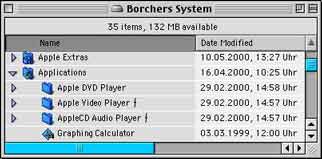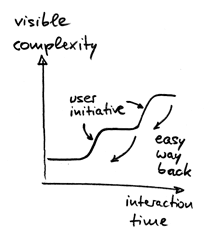| back to index | |||
H6 Incremental Revealing ** |
|||
 Lists of files in the Mac OS (R) Finder. |
|||
|
...you have sketched a design of your interface that conveys a
simple impression - Simple Impression, yet your system has more complex features that you wish to offer in order
to deliver its message - Attract-Engage-Deliver. Now
you need to balance these two goals of simplicity and complexity.
|
|||
|
* * *
|
|||
| Systems that look complex from the start do not invite
users. However, if a system does not offer enough complexity in its
interaction possibilities, using it can quickly become boring.
|
|||
| WorldBeat: Main screen plus components |
WorldBeat is structured into a short introductory screen, followed by a simple main selection screen with only names and icons of the main exhibit components (conducting, improvising, etc.) No lengthy texts overwhelm the user. But at this point, he has only scratched the surface of the exhibit. The overall wealth of features is presented in a gradual way: if the user moves the pointer towards one of the component icons, a short explanation appears (first revealing stage). Then, if he selects it, a separate page opens up that explains the component in more detail (second revealing stage), and lets the user try it out. |
||
| Expanding list views |
Most desktop operating systems, such as the Mac OS (R) shown in the opening picture, offer views onto the file and folder hierarchy that initially only show top-level items. Only when the user is interested in the contents of one of those objects does it unfold to reveal the next level of detail of the file hierarchy in this part. |
||
|
Therefore: Initially, present only a very concise and simple overview of the system functionality. Only when users become active - showing that they are interested in a certain part of this overview - offer additional information about it, and gradually reveal what is lying "behind" this introductory presentation. |
|||
 |
|||
|
* * *
|
|||
|
Especially for information-oriented systems, a simple
hierarchic structure to organize the revealing process is often
useful - Flat And Narrow Tree. To insert
an additional revealing layer, and make the process more continuous,
use temporary descriptions showing what the next revealing stage
contains - Dynamic Descriptor.
|
|||
This pattern is taken from the book "A Pattern Approach to Interaction Design" (PAID) by Jan Borchers (John Wiley and Sons, Chichester, UK, 2001). Copyright 2001 John Wiley and Sons. Used by permission. See http://media.informatik.rwth-aachen.de/paid.html for more information. Online version by Susan Babutzka, ETH Zurich (subabutz_at_student.ethz.ch). |
|||